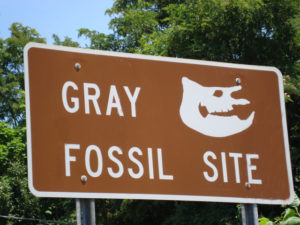
Originally published in the Bristol Herald Courier
Long before highways or buildings, the tiny town of Gray in southern Washington County was crawling with saber-tooth cats, shovel-tusked elephants and tapirs.
The prehistoric animals foraged and raised their young before they died, leaving their remains deep below what’s now state Route 75. For the past seven years, anthropologists have been carefully sweeping away the dirt and digging up the bones. Thursday morning, the scientists proudly displayed their findings in a new $10 million museum called the East Tennessee State University and General Shale Brick Natural History Museum and Visitor Center.
“This is the birth of a new museum. And that really doesn’t happen that much anymore,” said Steven Wallace, director of the new Don Sundquist Center of Excellence in Paleontology.
A handful of state and local government and business leaders got a sneak peek inside the 33,000-square-foot facility and were truly wowed by the sights.
“The first two times I came here, it was outdoors, on the site, in inclement weather and not dressed for the occasion,” said James Fyke, commissioner of Tennessee’s Department of Environment and Conservation. “I’m not sure what I expected of this facility, but I’ll tell you what, it exceeded it.”

Inside, the museum has all the intricate features of a fresh, new building — the walls boast a fresh coat of paint, the floor tiles shine proudly with a healthy glow and the gray-colored stairs show few signs of shoe exposure. The museum also has a “Fossil Assembly Station” where patrons can use a computerized touch screen to click and drag bone pieces together.
Many of the exhibits have touch-screen monitors that tell visitors biological information about the animals.
Richard Green, CEO of General Shale Brick, said the building nicely combines modern architectural technology with places for scientific research.
Down one curving and colorful hallway, glass displays on both sides show tiny animal teeth, bones, tusks, jaws, whole Page 1 skeletons and even turtle shells. Every display is accompanied by a paragraph of text that explains details about each animal.
Overall, scientists in the museum say these animals lived roughly 4.5 to 7 million years ago during the Miocene time period.
“But when you look at the exhibits here, I want you to think about not what we’ve found, but what we might find later,” Wallace said smiling.
The museum is set to open to the public today. However, it took years for local officials to reach this point.
The story starts back in May 2000 when Tennessee Department of Transportation crews were working on a Route 75 road-widening project. One worker found bones underground.
Former Gov. Don Sundquist ordered the road work moved to the north so the discovery could be preserved.
“We moved in as quickly as we could to fence it in,” Sundquist said Thursday. “I came home so excited when I thought of the possibly of this.”
Scientists spent years digging up bones around a 5-acre area and later identified more bones as ground sloths, rhino, camel, red panda, Eurasian badger and tapirs.

Scientists will continue to excavate at the Gray Fossil Site even after the museum opens. Visitors, and eventually school buses full of children, will be able to watch scientists work a site and identify remains.
Gray will be one of few places that hosts a museum and live archaeological dig. The closest to Tennessee is the Mammoth Fossil Site in Hot Springs, S.D.
“The locals are going to be so proud of this site, and they should be,” Wallace said.
Although they’ve been working for seven years, the scientists say they’ve only unearthed less than 1 percent of the remains on site.
Jeanne Zavada, the museum’s director, said when new remains emerge, the museum’s displays will change. Those in attendance Thursday thanked Sundquist for halting the road construction, which eventually led to the new museum.
Sundquist stood before that crowd and gave his forecast for the new museum.
“I am so impressed — this exceeds any dream I ever had for it,” he said. “I predict this will be a major tourist attraction in Tennessee. And it should be.”